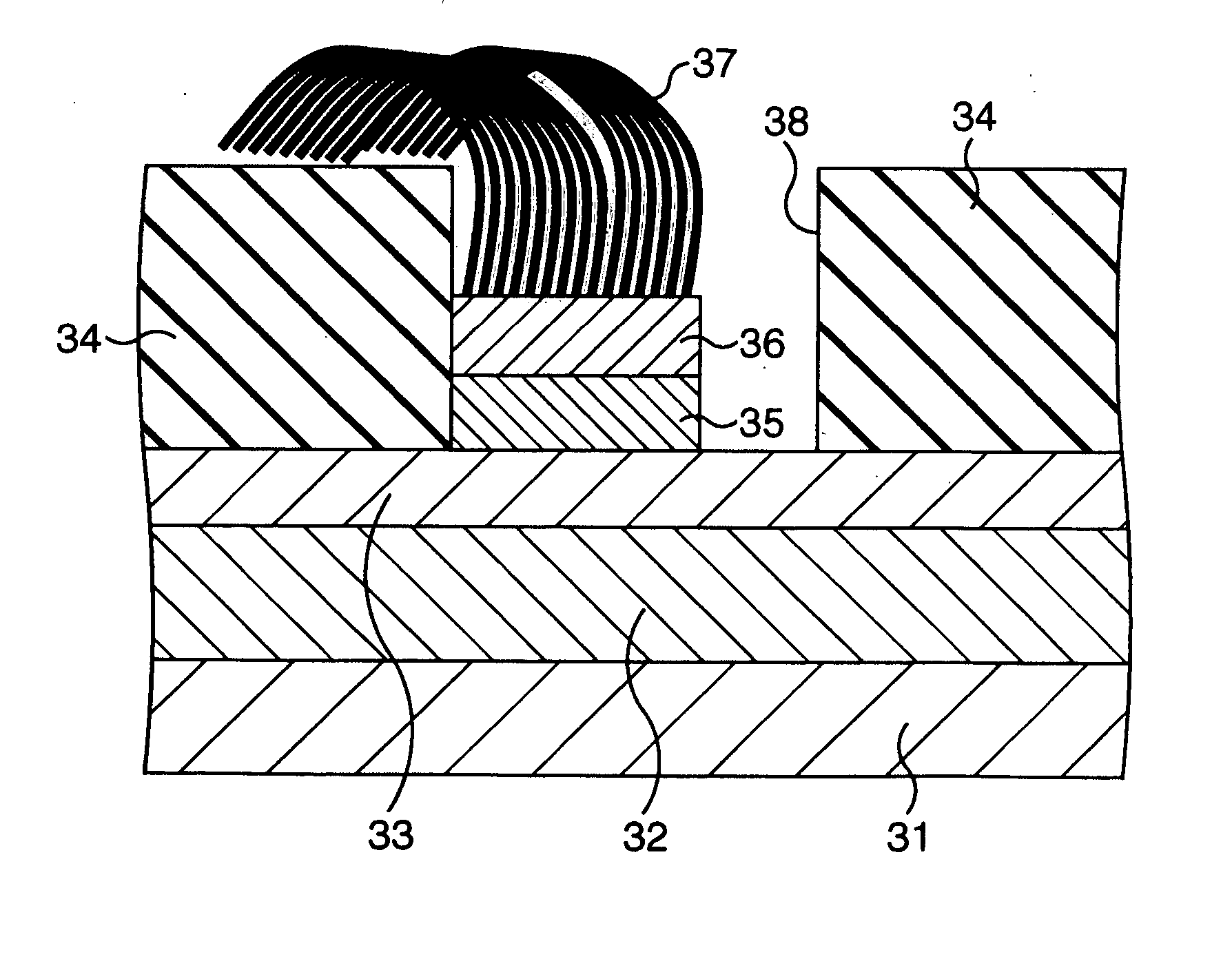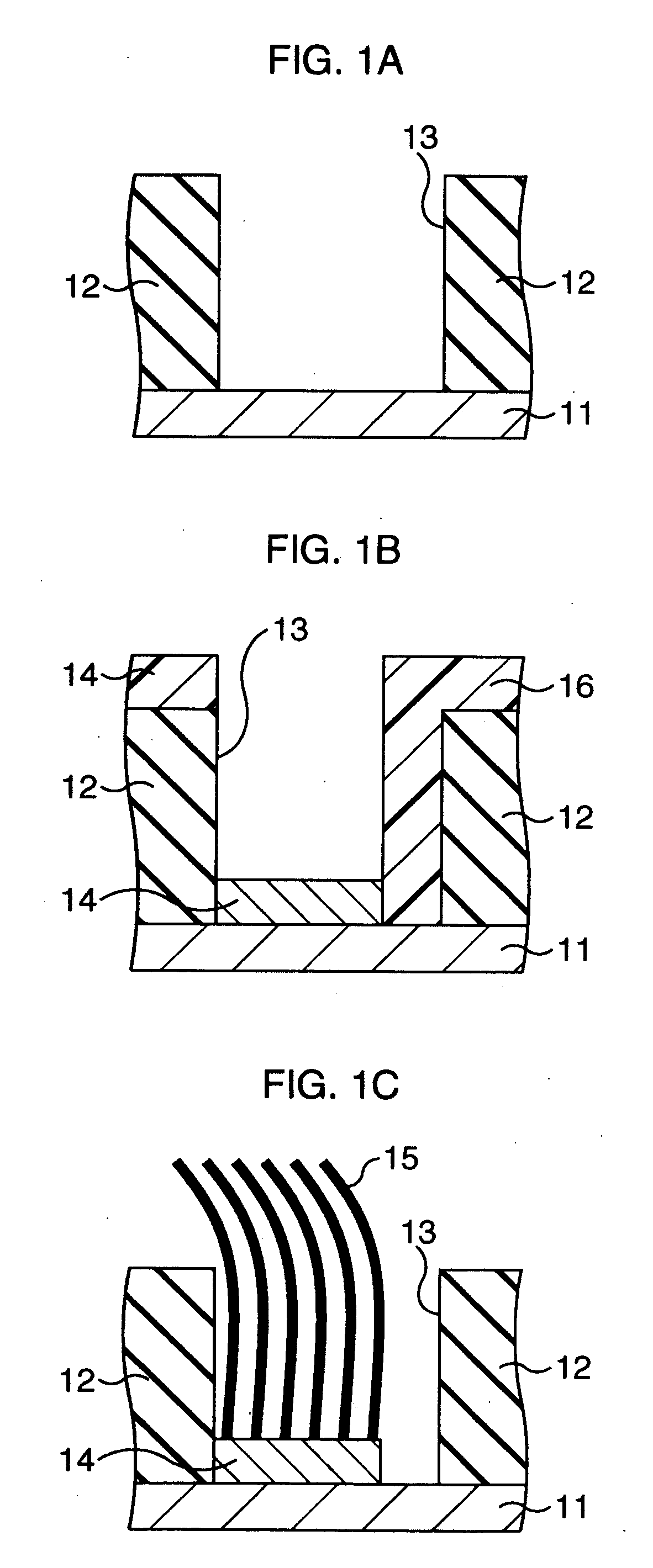Carbon nanotube device and manufacturing method of the same
a carbon nanotube and manufacturing method technology, applied in the direction of carbonsing rags, fibre chemical treatment, fibre treatment, etc., can solve the problems of inability to connect between two spots apart from each other horizontally by carbon nanotubes, and the shape limitation of carbon nanotubes formed according to these methods
- Summary
- Abstract
- Description
- Claims
- Application Information
AI Technical Summary
Benefits of technology
Problems solved by technology
Method used
Image
Examples
first embodiment
[0034] First Embodiment
[0035] Firstly, a first embodiment of the present invention will be explained. FIG. 1A to FIG. 1C are sectional views showing a manufacturing method of a carbon nanotube device according to the first embodiment of the present invention in process order.
[0036] In the first embodiment, as shown in FIG. 1A, a SiO2 film 12 is first formed on a silicon (Si) substrate 11. The SiO2 film 12 is, for instance, about 350 nm in thickness. Next, a cylindrical opening 13 is formed in the SiO2 film 12 by patterning with a resist pattern (not shown). The opening 13 is, for instance, about 2 μm in diameter.
[0037] Then, a resist film is formed on the entire surface, and a resist pattern 16 is formed by patterning the resist film, as shown in FIG. 1B. The resist pattern 16 has a shape covering the bottom of the opening 13 on only one side. As a result, the Si substrate 11 is exposed only from a part of the opening 13. In the present embodiment, especially when the resist patte...
second embodiment
[0043] Second Embodiment
[0044] Next, a second embodiment of the present invention will be explained next. FIG. 4A to FIG. 4C are sectional views showing a manufacturing method of a carbon nanotube device according to the second embodiment of the present invention in process order.
[0045] First, in the second embodiment, as shown in FIG. 4A, a catalytic layer 24 is selectively formed on a Si substrate 21. As the catalytic layer 24, for instance, a cobalt (Co) film having a thickness of about 1 nm is formed.
[0046] Next, a SiO2 film 22 is formed over the entire surface thereof. Then, a groove 23 is formed in the SiO2 film 22 by patterning using a resist pattern (not shown). The thickness of the SiO2 film 22 is, for instance, about 350 nm. When forming the groove 23, as shown in FIG. 4B, both of the Si substrate 21 and the catalytic layer 24 are to be exposed from the groove 23.
[0047] Thereafter, as shown in FIG. 4C, carbon nanotubes 25 are grown on the catalytic layer 24. At this tim...
third embodiment
[0050] Third Embodiment
[0051] Next, a third embodiment of the present invention will be explained next. FIG. 7A to FIG. 7B are sectional views showing a manufacturing method of a carbon nanotube device according to the third embodiment of the present invention in process order.
[0052] In the third embodiment, first, as shown in FIG. 7A, a copper (Cu) film 32 and a tantalum (Ta) film 33 are formed in sequence on a Si substrate 31 by, for instance, a sputtering method. The Cu film 32 and the Ta film 33 are about 150 nm and about 5 nm in thickness, respectively. Then, a SiO2 film 34 is formed over the entire surface. The SiO2 film 34 is, for instance, about 350 nm in thickness. Next, a cylindrical opening 38 is formed on the SiO2 film 34 by patterning with a resist pattern (not shown). The opening 38 is, for instance, about 2 μm in diameter.
[0053] Then, similarly to the first embodiment, a resist film is formed on the entire surface, and a resist pattern (not shown) is formed by patte...
PUM
 Login to View More
Login to View More Abstract
Description
Claims
Application Information
 Login to View More
Login to View More - R&D
- Intellectual Property
- Life Sciences
- Materials
- Tech Scout
- Unparalleled Data Quality
- Higher Quality Content
- 60% Fewer Hallucinations
Browse by: Latest US Patents, China's latest patents, Technical Efficacy Thesaurus, Application Domain, Technology Topic, Popular Technical Reports.
© 2025 PatSnap. All rights reserved.Legal|Privacy policy|Modern Slavery Act Transparency Statement|Sitemap|About US| Contact US: help@patsnap.com



